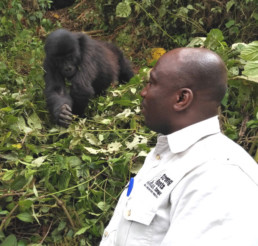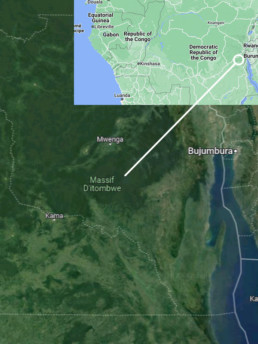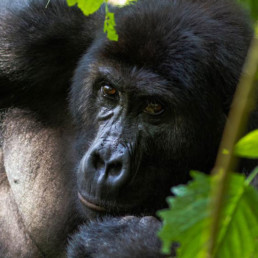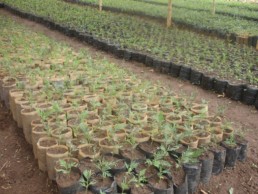Location
South-Kivu Province, eastern Democratic Republic of the Congo (DRC)
Goal
Advance the conservation of Grauer’s gorilla and other threatened species in the eastern Congo Basin.
Project Field Partner
Founded in 2009, Strong Roots is a community-based organization working at the nexus of conservation and sustainable development. They work with communities who live on the borders of Protected Areas and those living in community forests.
Size of Area Involved
6,000 km²
A wealth of life along the rift
Grauer’s Gorilla (Gorilla beringei graueri), endemic to the Albertine Rift escarpment in eastern Democratic Republic of Congo, has suffered a rapid population decline (70%) in the last 20 years. It is now listed as Critically Endangered (CR) in the IUCN Red List. The rich biodiversity of the area includes the Itombwe Massif Clawed Frog (CR), Prigogine’s Nightjar (EN), Prigogine’s Greenbul (EN), Chimpanzee (EN), Congo bay-owl (EN), Itombwe Golden Frog (EN), Yellow-crested Helmet-shrike (VU), and African Forest Elephants (CR).

Threats:
Primates in the DRC are primarily threatened by the mining of precious minerals at artisanal and industrial scale, poaching and pollution of soil and ground water. Mining is the main driver of armed conflict in the region and stimulates human migration, wildlife trafficking, illegal logging for charcoal, colonization of forested areas, bushmeat hunting, and the construction of temporary roads in the forests. The extreme poverty in the region and the communities’ reliance on slash-and-burn agriculture are also drivers of great ape habitat degradation and fragmentation. All of this has led to a rapid population decline of Grauer’s gorilla from an estimated 16,900 individuals in the wild in the mid-1990s to fewer than 3,800 individuals today.
However, recent surveys conducted by the Wildlife Conservation Society and the Congolese Wildlife Authority show an 18% increase in Grauer’s Gorilla numbers in the high-altitude sector of Tshivanga in Kahuzi-Biega National Park resulting from conservation efforts by organizations such as field partner Strong Roots and the increased presence of the Congolese Wildlife Authority. This shows what is possible.
Constructing a biological corridor
In August 2022 years of work by Strong Roots and the communities succeeded in getting approval for thirteen officially designated Forestry Concessions for Local Communities (CFCL) covering over a quarter million hectares. This is a phenomenal achievement! Six more CFCLs await approval.
This is part of an ambitious plan to empower local communities and indigenous peoples to manage and protect their traditional lands. This forms part of a ~6,000-km² biological corridor connecting Parc National de Kahuzi-Biega to the Réserve Naturelle d’Itombwe. Crucially, the project will benefit local communities beyond simply giving them control of their forests. Strong Roots works with communities to develop sustainable livelihoods such as climate-smart agriculture and beekeeping.
Eventually community members will be included in great ape monitoring and patrolling and reforestation in the corridor area with agroforestry and native tree species. At last count, 4,212 households are direct beneficiaries of the project—people involved in carrying out its programs. These encompass 129 clans, 7 Chiefdoms, in 333 villages.




